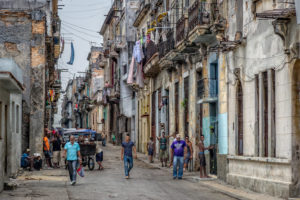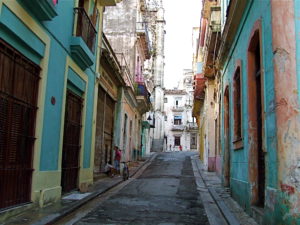“Virulilla”.
In 1919, after the end of World War I, the Cuban market was flooded with khaki and denim fabrics.
They were very cheap and there was, on the other hand, much more to choose from. There were no Japanese straw to make hats. It was thus that the Cuban imagination created a new fashion: pants and khaki skirts and denim shirts and blouses, while the old and worn hats, once wet, conformed to the taste of the consumer and were painted with the color of their preference. This fashion was called virulilla and virulillas were used.
The Alhambra theater recorded the event. On January 12, 1920, the book entitled La alegría de la vida (The joy of life) was released in the famous consulate and Virtudes coliseum, with a libretto by Federico Villoch and music by Jorge Anckermann. Coplas of Virulilla.
Virulilla, tie your cat, / if you spider me, I’ll kill you. / Virulilla, tie Pepito, / if he kisses me, I’ll take it away …
They were sung by Sergio Acebal and Alicia Rico and were very successful with them. And virulilla remained in the vernacular language as synonymous of thing chabacana, minor and insignificant. Relative relative of virgulilla, word that the Academy of the Spanish Language defines as any short hairline and very thin.
“Viruta”.
Before World War I, Pancho Hermida (La Discusión) was one of the tsars of Havana’s theater criticism along with Count Kostia (La Lucha), Amadís (El Mundo) and Zerep (El Triunfo). Every night Hermida made its way through the theaters: Alhambra, National, Payret, Martí, Albisu and News. It was an invariable routine with more or less extended stays where there was an interesting premiere or rock.
Once, arriving at the Alhambra, he noticed that he was being followed by a sultan dog, colored cinnamon, with visible signs of appetite, and he bought a fried in the cafe of the same theater. It was a symbolic act that sealed an unshakable friendship. The sate was baptized in the Alhambra as Chip, and Chipped each night, for years, accompanied Hermida in its travels. When Hermida died, Chip continued to make only his theatrical journey until one day he passed himself as a remembrance more of the Habanero altarpiece. Chip, the cinnamon sato farandulero.
“Potaje”.
In the mid-1920s, Creole idiosyncrasy showed a perceptible jolt. A will to overcome and change. The artistic avant-gardes appeared, the magazines wanted to be advanced, and the newspaper El País insisted on entering the new wave: it acquired a Waco airplane, discovered, with the purpose of carrying to Santa Clara the matrices of the newspaper in order to throw there the An edition that would be distributed in the eastern provinces. It was a good propaganda for El País that immediately added a plane as a background to his head in Gothic letters.
To man the equipment that each afternoon was to arrive in the city of Marta, they hired a famous motorcycle and motorcycle rider, winner of many automotive competitions and star seller of luxury vehicles. He was a Galician named Emiliano Solorzano, but everyone knew him by the nickname of ‘Potaje’.
Soon the fame of the pilot grew like the foam, both in the towns that he flew daily, and where he made pirouettes in the air as a greeting to his admirers, as in the very habanera zone of tolerance of Columbus, where he knew of the points that he wore .
In the long run, the adventure of the plane and the eastern edition of the newspaper were not affordable. But in the title of El País remained the image of the apparatus and in the popular memory the nickname of Potaje.
Tres Historias de mi Vieja Habana: “Virulilla”, “Viruta” y “Potaje”.
“Virulilla”.
En 1919, tras el fin de la Primera Guerra Mundial, el mercado cubano se vio inundado de telas de caqui y de mezclilla.
Eran muy baratas y no había, por otra parte, mucho más para escoger. Tampoco había pajilla japonesa para confeccionar sombreros. Fue así que la imaginación del cubano creó una nueva moda: pantalones y faldas de caqui y camisas y blusas de mezclilla, mientras que los viejos y gastados sombreros, una vez mojados, se conformaban al gusto del consumidor y se pintaban con el color de su preferencia. Esa moda se llamó de virulilla y eran virulillas los que la usaban.
El teatro Alhambra registró el hecho. El 12 de enero de 1920 se estrenaba en el célebre coliseo de Consulado y Virtudes, con libreto de Federico Villoch y música de Jorge Anckermann, la obra titulada La alegría de la vida, que, entre sus 12 números musicales, daba entrada a las famosas coplas de Virulilla.
Virulilla, amarra a tu gato, / si me araña, yo te lo mato. / Virulilla, amarra a Pepito, / si me besa, yo te lo quito…
Las cantaban Sergio Acebal y Alicia Rico y fue mucho el éxito que cosecharon con estas. Y virulilla quedó en el lenguaje vernáculo como sinónimo de cosa chabacana, barriotera e insignificante. Pariente más o menos cercano de virgulilla, vocablo que la Academia de la Lengua Española define como cualquier rayita corta y muy delgada.
“Viruta”.
Antes de la Primera Guerra Mundial, Pancho Hermida (La Discusión) era uno de los zares de la crítica teatral habanera junto con el Conde Kostia (La Lucha), Amadís (El Mundo) y Zerep (El Triunfo). Cada noche Hermida hacía su recorrido por los teatros: Alhambra, Nacional, Payret, Martí, Albisu y Actualidades. Era una rutina invariable con estancias más o menos dilatadas donde hubiera un estreno o una peña interesante.
Una vez, llegando al Alhambra, notó que lo seguía un perro sato, color canelo, con visibles señales de apetito, y le compró una frita en el café del mismo teatro. Fue un acto simbólico que selló una amistad inquebrantable. Bautizaron al sato en Alhambra como Viruta, y Viruta cada noche, durante años, acompañó a Hermida en sus recorridos. Cuando Hermida murió, Viruta siguió haciendo solo su recorrido teatral hasta que un día pasó él mismo como un recuerdo más del retablo habanero. Viruta, el canelo sato farandulero.
“Potaje”.
A mediados de los años 20 hubo en la idiosincrasia criolla una perceptible sacudida. Una voluntad de superación y cambio. Aparecieron las vanguardias artísticas, las revistas quisieron ser de avanzada, y el periódico El País insistió en entrar en la nueva onda: adquirió un avión Waco, descubierto, con el propósito de llevar a Santa Clara las matrices del diario a fin de tirar allí la edición que se distribuiría en las provincias orientales. Fue una buena propaganda para El País que de inmediato agregó un avión como fondo a su cabezal en letras góticas.
Para tripular el aparato que cada tarde debía arribar a la ciudad de Marta, contrataron a un famoso corredor de automóviles y motocicletas, ganador de muchas competencias automovilísticas y vendedor estrella de vehículos de lujo. Era un gallego llamado Emiliano Solórzano, pero todos lo conocían por el sobrenombre de ‘Potaje’.
Pronto la fama del piloto creció como la espuma, tanto en los pueblos que sobrevolaba diariamente, y donde hacía piruetas en el aire como saludo a sus admiradoras, como en la muy habanera zona de tolerancia de Colón, donde se sabía de los puntos que calzaba.
A la larga, la aventura del avión y la edición oriental del periódico no resultaron costeables. Pero en el título de El País quedó la imagen del aparato y en la memoria popular el apodo de Potaje.
Agencies/Felix Soloni/Internet Photos/Arnoldo Varona/TheCubanHistory.com
THE CUBAN HISTORY, HOLLYWOOD.










